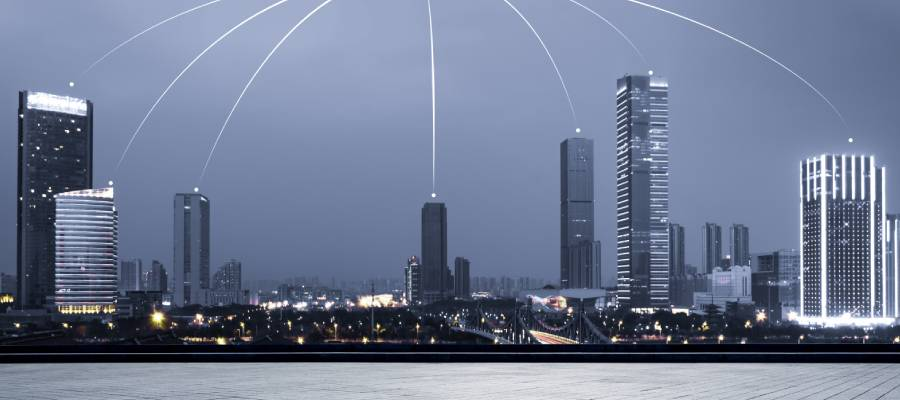If an 8-channel gateway supports 1.5 million packets per day and the application sends 1 packet per hour, the gateway can handle over 62000 nodes. In theory, it can be done using network topology, but LoRa is only defined for star topology structures.
How LoRaWAN Works
At the most basic level, wireless protocols like LoRaWAN are quite simple. The communication mode of the interstellar network is similar to the conversation between professors and students in lectures. The gateway (professor) communicates with the terminal node (class), and vice versa. In terms of communication, this is an asymmetric relationship. Everyone in the class can try to communicate with the professor at the same time, but the professor cannot hear or understand them at the same time. Although too simplistic, many elements of stellar topology can be traced back to this analogy.
The working principle of LoRa is to move the RF tone over time in a very linear manner. This figure shows the chirping sound in a reverse waterfall - the latest data is located at the top, called "upward chirping". You can see how the frequency of this tone increases over time. LoRa transmission operates through chirping sound, breaking chips at different positions in terms of time and frequency to encode symbols. The fact that LoRa transfers from one place to another at a specific time may mean that one bit string is associated with another bit string. It is not just a simple binary file, it also has a lot of information that you can convey (high symbol depth).
Think about frequency shift keying (FSK). If a tone remains stationary for a period of time and then jumps to another place for a period of time, you will see different lines or tones. This is called 2-ary FSK, representing two frequency symbols. M-ary FSK has multiple frequency tones, which can represent more symbols. LoRa adopted this concept, but it did everything in the chirping sound. So, it is gaining processing gain. Due to the unique mode of the LoRa receiver, it can detect quieter chirping sounds, which are lower than the background noise. If another transmission occurs at different chirp rates in the same channel, it is orthogonal, which means it can be detected simultaneously. In summary, the receiving end has a lot of capacity.

LoRaWAN has three classes running simultaneously.
Class A is purely asynchronous, which is what we call a pure ALOHA system. This means that terminal nodes do not wait for a specific time to communicate with the gateway - they only need to transmit when needed and remain dormant until then. If you have a perfectly coordinated system with more than eight channels, you can fill each time period with one message. Once one node completes the transmission, the other node will immediately start. In the absence of any communication gaps, the theoretical maximum capacity of a pure aloha network is approximately 18.4% of that maximum capacity. This is mainly due to conflicts, as if one node is transmitting and another node wakes up and decides to use the same radio settings to transmit on the same frequency channel, they will collide.
Class B allows messages to be sent down to battery powered nodes. The gateway transmits a beacon every 128 seconds. (Please refer to the time period at the top of the figure. All LoRaWAN base stations transmit beacon messages at the same time because they belong to one pulse per second (1PPS).). This means that each GPS satellite in orbit sends a message at the beginning of each second, synchronizing time around the world. All B-class nodes are allocated a time period within a 128 second cycle and are informed when to listen. For example, you can tell the node to listen every ten time slots, and when this happens, it allows for the transmission of downlink messages.
Class C allows nodes to continuously listen and can send downlink messages at any time. This is mainly used for AC power supply applications, as maintaining the node in an active wake-up state requires a large amount of energy to operate the receiver.
Obstacles to building a dedicated network using LoRaWAN
LoRaWAN is suitable for certain applications, but it is not the best choice for customer deployment (also known as dedicated network) solutions. The main reasons are:
The coexistence of multiple gateways allows for interference. Using LoRaWAN, all gateways (regardless of who owns or operates them) are tuned to the same frequency. This means that your LoRaWAN network can see all of my traffic, and vice versa. It is best to run only one network in a single area to avoid collision issues.
However, specific channels can be reserved for specific purposes through the LoRa alliance. Network operators can also limit the amount of downlink in their network from the server side to ensure that low-priority endpoints do not "block" the network due to downlink traffic. It does not guarantee receiving messages.
LoRaWAN is an asynchronous protocol based on ALOHA, where a packet error rate (PER) of over 50% is common. This is good for some meter reading applications, but for industrial or enterprise sensor networks or control systems, 0% PER is necessary. The "spray and Prayer" method of messaging is not suitable for most industrial use cases, which is why LoRaWAN is most suitable for the network centered on the upper chain.
It requires a lot of development work. Another challenge our customers face is that LoRaWAN mainly consists of the Data Link (MAC) layer (OSI layer 2), with only certain elements of the network layer (OSI layer 3). As of today, there are no suppliers providing end-to-end LoRaWAN solutions. On the contrary, you need to collaborate with multiple suppliers to obtain nodes, gateways, backend servers, and all other parts of the ecosystem separately. Although this provides great flexibility for applications, it leaves a lot of work for application developers to generate complete products. This includes grouping, downlink control, multicast, and more.
There is a duty cycle limitation. There are some inherent limitations in the 868 MHz frequency band in public networks. In Europe, the main limitation is a duty cycle of 1% (in most cases). This means that if the average length of time transmitted by the gateway over time is measured, it cannot exceed one percent. Therefore, the amount that a gateway can transmit is very limited. In the United States, the FCC does not have such restrictions on the ISM frequency band.
It has a variable maximum transmission unit (MTU) payload size. Another major limitation of LoRaWAN is that the MTU payload size varies depending on the propagation factors assigned to nodes by the network. In other words, if you are far from the gateway, the number of bytes you can transmit is very small, but if you are close, it will be much larger; You simply cannot know this in advance. Therefore, node firmware or applications must be able to adapt to changes in the application layer payload side, which is very challenging when developing firmware.
Most developers solve this problem by selecting the smallest available MTU based on the highest propagation factor that can be allocated on the network (usually very small, usually less than 12 bytes). Therefore, LoRaWAN nodes that need to send a large amount of data (such as 300 bytes) must send 30 10 byte messages, as they may face situations where a small number of MTUs are allocated. Therefore, due to the complex software changes required to handle these constantly changing MTU values, the transmission volume of these nodes far exceeds the necessary range.
Contact: Qui
Phone: 18146178586
Tel: 18146178586
Email: qui@zonewu.com
Add: 1501-3, Building F03, Phase III, Software Park, Jimei District, Xiamen City, Fujian Province, China
